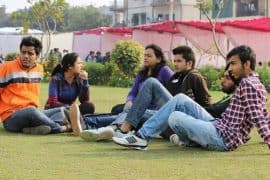Lack of commercial significance and unwillingness of students to pursue the language courses has resulted in fewer students opting for these fields; primarily, Hindi and Sanskrit. Here’s exploring the reason behind this pattern.
The academic world has been taken by storm by the prominent rise of Commerce and Economics as primary fields of higher education. It is thus inevitably assumed that if the class XIIth board examinations do not go in one’s favour, the recent pass-out is fated to opt for these language-specific arts courses as a browbeaten backup. The streams of Hindi, Sanskrit, and their likes have been destined to fall into this unfortunate category.
With its origin dating back to the second millennium, Sanskrit is one of the oldest languages to exist today. Emerging from the roots of it is our official language Hindi, which was derived back in the 7th century AD. Hindi is the fourth most-spoken language, with approximately 490 million people making use of it. Sanskrit is the official state language of Uttarakhand. Given their history and usage, there are hardly a few more languages that are as decorated as these two.
However, when it comes to studying these subjects at the undergraduate level, the numbers aren’t as staggering as that of the commerce courses. In the University of Delhi, there are about 45 colleges that offer B.A. (Hons.) Hindi, and only about 25 colleges that offer B.A. (Hons.) Sanskrit. Even after a limited number of seats for these courses, the seats fill up rather slowly. However, having said that, there has been an increase in the number of students pursuing these courses in the recent years.
Speaking to DU Beat, Dr. Subhash Chandra, Assistant Professor in the Department of Sanskrit, said
“The slow growth is due to the high demand of job-oriented courses in the market. The research and development in these subjects require students who are completely focused on these subjects which are very few.”
It cannot be refuted that the commercial significance of these languages is not as high as the commerce courses. Also, the lack of placements of students pursuing these courses is a huge factor contributing to the stagnation.
In this age of advancement, it is understandable that students want to pursue courses that offer better career-building prospects. The kind of scope and number of opportunities that the mainstream courses provide are incomparable; whereas, these language courses are more about research and exploration. Also, these courses require immense effort and a higher degree of knowledge which results in a long and continuous studying phase. However, these are not the only reasons that act as a hindrance. Dr. Sanjay Kumar, Associate Professor of Hindi Department, opines that
“Hindi and Sanskrit languages cannot restore their place as long as there is no change in the system. Our studying curriculum involves the use of English mostly as it is regarded as an elite language.”
The fact that a few students opt for these courses only when they are unable to find other courses does not help the situation. The use of English in studying directly encourages students to learn and use English. As highlighted in the statement, the discrimination of Hindi and Sanskrit very much explains why there is a scenario of fewer students opting for these courses.
Regardless of the usage of English, the fact stays that it is a secondary language for us. Owing to the choice-based credit system (CBCS) introduced by DU, the number of students studying Hindi and Sanskrit have increased. Students pursuing other courses can opt for these subjects simultaneously if they wish to. Also, these languages are a part of the curriculum which makes it compulsory for students to study it. Adarsh Kumar, a third-year student of B.A. Hons. Hindi of Shaheed Bhagat Singh College says,
“I don’t feel like there is a lack of opportunities in this program. The course covers a lot of things and I have learned a lot of things. I am very happy with the curriculum.”
Maybe we need to revamp the current backdrop to bring a change. Maybe we just need to open up doors of opportunities that make the language courses seem lucrative. Maybe we need something more drastic. We need to take this trend of increasing number of students in these courses to a higher level, where one day students might be standing in the queue for hours to enroll themselves in this program. Hopefully, one day, we can relish studying the language that is our own.
Feature Image Credits: Language Services Bureau
Karan Singhania





Comments are closed.